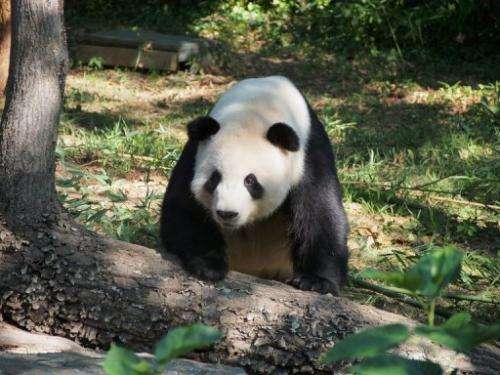Washington's new panda cub is a girl, zoo says

The giant panda cub born 13 days ago at the National Zoo in Washington is female and she has a live-in dad, the zoo said Thursday.
"We have another girl in our family," said research scientist Jesus Maldonado of the zoo's genetics center as father Tian Tian lounged in the morning sunlight and mother Mei Xiang tended to her newborn in private.
Yet to be named, the tiny offspring is the happy outcome of a successful attempt at artificial insemination using a mix of fresh and 10-year-old frozen semen from Tian Tian.
"I'm very happy to report she is absolutely beautiful," said Brandie Smith, the zoo's senior curator of mammals and giant pandas.
"It has a fat little belly. It's very active. It's very vocal.... It's getting healthier and stronger every day," she told reporters.
The zoo used DNA samples from buccal swabs as well as chromosome tests to pinpoint the cub's paternity and gender.
Mei Xiang had been inseminated twice—once with semen from Tian Tian, with whom she had failed to mate naturally, and a second time with a mix of semen from both Tian Tian and Gao Gao, a giant panda at California's San Diego zoo.
She carried twins, but the second cub was stillborn, suffering from a fetal development abnormality that left it with only half its skull, said reproductive biologist Pierre Comizzoli of the zoo's species survival center.
"What we are trying to understand is how this happened," he said.

The cub, about the size of a stick of butter, weighed in at a normal 4.8 ounces (137 grams) at birth. Following Chinese tradition, she won't be named until 100 days after her birthday, in early December.
She is not expected to go on public view before early next year, although so many people around the world are watching her on the zoo's Internet "pandacam" that viewing time is being limited to 15 minutes.
After two years, the newest member of Washington's panda family will be sent to China and become part of a breeding program there, as part of a cooperative breeding agreement.
Pandas are notoriously reluctant breeders when held in captivity. Fewer than 1,600 pandas remain in the wild, mainly in China's Sichuan province, with a further 300 in captivity around the world.
But this summer has been particularly busy in the panda world.
Just last Friday, Hua Zui Ba, already a mother of twins, gave birth again in a Madrid zoo after a gestation period lasting 131 days, zoo officials in the Spanish capital announced.
In mid-August, the Vienna zoo said its pandas Yang Yang and Long Hui had given birth to the first cub ever conceived by natural means in a European zoo.
Taiwan's first newborn panda, Yuan Zai, was meanwhile reunited with her doting mother Yuan Yuan after spending time in an incubator to recover from a leg injury sustained soon after her birth on July 7.
In the southern US state of Georgia, at Zoo Atlanta, Lun Lun gave birth to twins in July at Zoo Atlanta—the first double birth of giant pandas in the United States in 26 years.
And in China, Haizi, a giant panda at the Wolong Nature Reserve in southwestern Sichuan province, gave birth to twins in June—the first double birth of giant pandas anywhere in the world this year, state media reported.
Washington's Mei Xiang—who had five false pregnancies from 2007 to 2012—gave birth to a female cub in September 2012, but it died six days later from liver damage due to underdeveloped lungs.
Her first cub, Tai Shan, was born in July 2005 as a result of artificial insemination. He now resides at the Bifengxia Panda Base in Ya'an, in Sichuan province.
More information: nationalzoo.si.edu/animals/giantpandas/default.cfm
© 2013 AFP


















